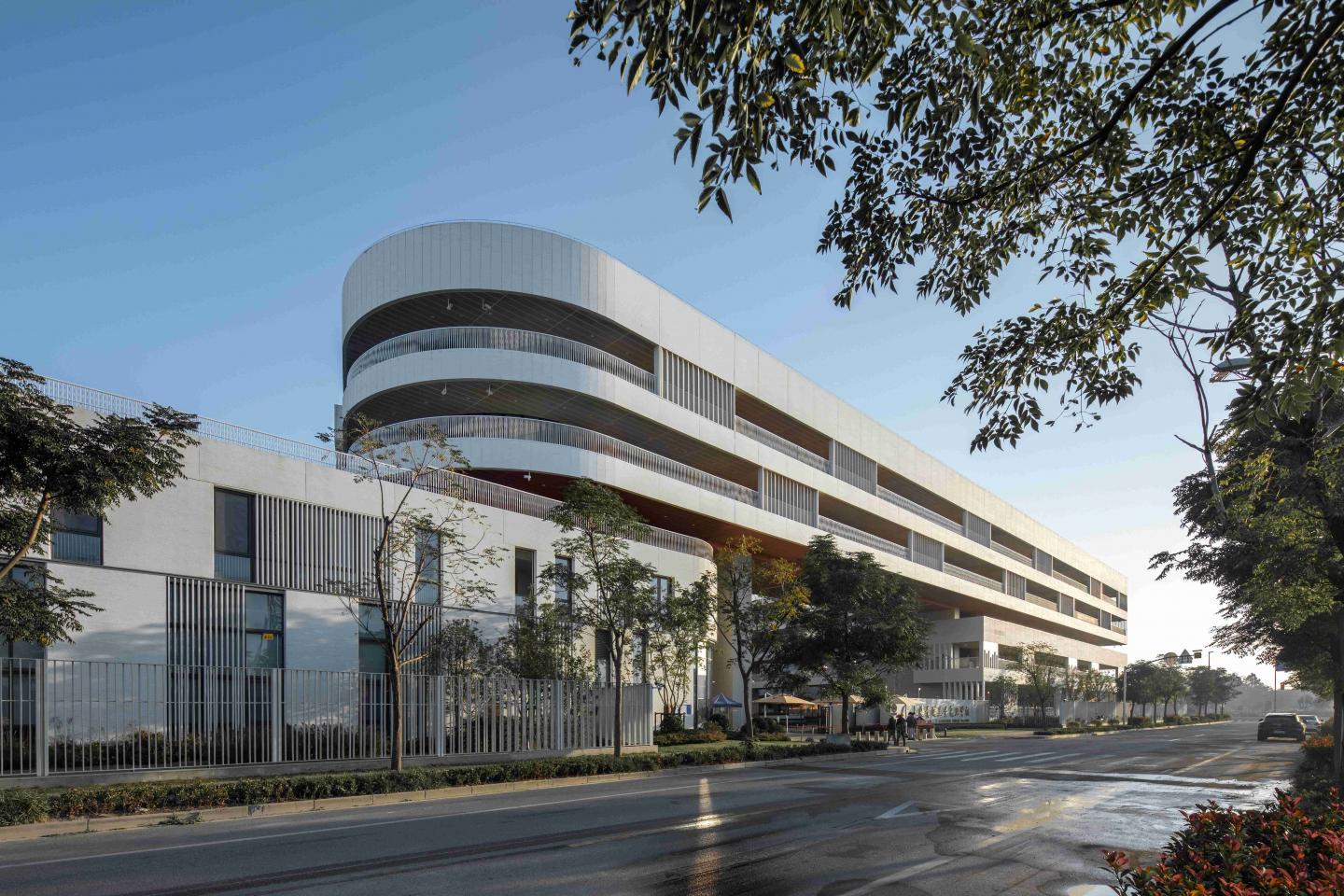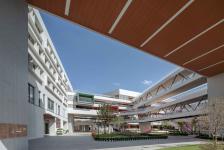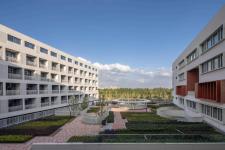In recent years, the pedagogy in Chinese educational institutions has been shifting from a teacher-centred model that relies on direct instruction, to a more holistic, student-centred experiential learning model. This calls for creative architectural design approaches towards the transformation of educational architecture.
The school is located in the new town area of Zhujiajiao township, Qingpu District. With a land area of 53,581.15 square meters, the complex offers preschool, primary and secondary education with a total floor area of 79726.92 square meters.
Dynamic Playground – Campus Layout
· Multiple Courtyards
Lighting and orientation of teaching buildings are critical to the spatial organization of campuses. Bringing classrooms of all educational stages together into a single building volume would result in poor lighting and ventilation, as well as in an uninspiring relationship between indoor and outdoor space. The project seeks to increase the vitality of the campus by diversifying the layout of multiple teaching buildings around a series of courtyards that function as activity spaces for students. The design studied the movement and activities of students, and made activity spaces (especially the playground) as the central elements of the project. Activity spaces are also designed to be accessible from classrooms to meet the needs of a more dynamic pedagogical model. Separately, in consideration of the particular design requirements for preschool education, the kindergarten is arranged in a relatively segregated area.
The playground is placed at the centre of the site as the most public "great courtyard". In comparison, the smaller courtyards, enclosed by teaching buildings of different programme create multiple “quadrangles”, relatively more private. The quadrangle layout of classrooms creates a quiet and peaceful campus environment within the busy urban context.
Exploiting Existing Conditions
The design makes use of the site’s height difference, making the lowest area in the southwest corner a semi-underground parking lot and pick-up area. Above the parking area are grandstand facing the playground and green spaces designed to follow the terrain, as a response to the existing ground condition. While lowering the construction cost, such organizational approach also creates a more coherent and dynamic landscape.
Make Schooling a Scenic Journey
The homogeneous space and lineal circulation often seen in conventional campus design are not attractive to younger students as they are uninspired and unimaginative. Therefore, the design proactively explores the possibility of creating a dynamic public corridor that links the entire campus, treating the ground as a continuous landscape. This dynamic corridor is connected through staircases, ramps, steps, and suspended floors. These nodes, together with the roof garden, form a coherent shared space system. The dynamic corridor is generally arranged around the playground, connecting seven major programmes of the school: kindergarten, gymnasium, the Lansheng green space, art building, library, theatre, and canteen.
This series of inspiring, informal spaces for social and public activities are designed to promote communication and exchange between teachers and students. The spatial diversity of the corridor is achieved through the design of spaces of various scales and multiple height levels. Outdoor and semi-outdoor spaces with different enclosures could be viewed from different height perspective, creating rich spatial experiences. Efficiency is also valued in the circulation design.
Informal learning spaces are critical for experiential and self-learning, as they provide places for students to gather for discussions, as well as encourage independent thinking by offering comfortable solitude. The design creates various forms and scales of such spaces for teachers and students outside the classrooms.
The school’s "double-sided theatre" is one of these spaces. It is designed as a multi-functional venue for small performances, training, and lectures. For casual use, it can become a stage for students to organize and participate in extracurricular activities, such as drama and model conference. The indoor auditorium and the outdoor amphitheatre are separated by special glass, which creates both spatial division and visual connection.
The library on the other hand, provides students with a quiet, private space for studying and reading, encouraging solitude and knowledge sharing.
Spaces under the suspended floors offer shelter from rain and sun, providing children with comfortable places to play and communicate in all seasons. Roof gardens introduce green and sharing spaces in the vertical dimension, so that students can get closer to nature in an urban environment. The diversity of horizontal and vertical spatial compositions provides a rich spatial experience, which will incrementally improve children’s ability to perceive spatial relationships and influence their sense of creativity.
Thoughtful Visual Elements – Architectural Facades
Besides spatial forms, design details of building facades are also important to the spatial experience of students and teachers. The openings of the building envelope are of multiple variations, considering the varied needs of shading in different orientations. The colouring of the facades is based on a colour psychology study of different educational activities and for children of different age. These complex, varied components are unified through the design language of white lineal elements throughout the elevation design.
Influence of Order – White Lineal Elements
Order and discipline is greatly valued in the tradition of Shanghai Qingpu Lansheng School, fostering generations of outstanding students. The design hopes to translate such order into an architectural language. Simple and rhythmic vertical white lines are used as the major element of the facade.
Varied Door and Window Details
The styles of doors and windows in the building are unified, but they are not the same when viewed in detail. Such differences are determined by the lighting environment of each door and window, their positions and orientations. The use of bay windows in the teaching buildings introduces natural landscape into the teaching area. The sizes and opening types of the classroom windows are also given special consideration to highlight the picturesque landscape outside.
Lively spatial forms and bright colours are inspirational to young children. Brightly coloured windows are inserted on the orderly facade to make the teaching building more interesting. The design uses rhythmic changes of colours and patterns on the building envelope to create an imaginative space that can leave beautiful memories for the children inspiring their sprouting imagination.
Accompany and Nurture for a Future Full of Potentials
To shape a unique childhood experience for students is the true intention behind the project, other than merely creating space for an innovate teaching model and conceiving more interesting spaces. Sometimes it is just a beam of sunlight passing through the leaves or a leaf quietly falling onto an open book that leaves a mark on the growth of a child and trigger softness in his young heart. The diverse and welcoming spaces open up possibilities for future changes as the students and the school grow. When urbanization turns land into a concrete jungle, the design has, in a way, created a natural world that accompanies their growth and memory.
2018
2021
Site Area: 53581.15㎡
Floor Area: 79726.92㎡
Chief Designer: DONG Weiwei
Architectural Design Team: SHEN Yi, DONG Weiwei, HE Yuwei, SU Kang, YANG Tao, WU Ying, WANG Shijie, ZHOU Zhaomin, YU Lu, ZHAO Feiyao, CAI Baiyang, ZHOU Jun, FENG Xiaolong
Structural Design Team: ZHANG Yongqiang, XU Bingbing, CHAI Jingyuan, PU Yiwen
Water Supply and Drainage Design Team: JIANG Yi, WU Wenwen, LIU Miaomiao, WANG Yikun, ZHANG Ting
HVAC Design Team: CHAI Yunliang, DONG Yunfeng, MA Yiming, QIAO Xueliang, LIU Jiani
Mechanical and Electrical Design Team: ZHANG Xiaoqing, ZHANG Yi, WEI Quan, YUAN Jiangfeng, HAN Kejun, XIONG Tang
Interior Design Team: GE Qing, AI Jingwen, LIU Haitao, LIU Sihan, WANG Yijia
Landscape Design Team: ZHU Yiyu, WANG Dandan, CHEN Si, FEI Yidong, YANG Gang, LI Xinlei, SUN Heqiao
Project Management Team: YANG Qinglin, ZHUANG Qin
Photo: TANG Xuguo, Luca Forteleoni
Writted by: WANG Shijie,ZHU Ying,CHEN Fan
Favorited 1 times











